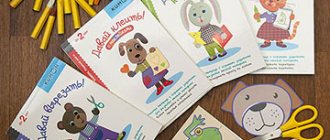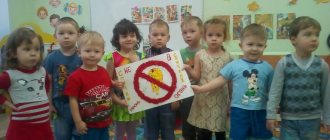Junior group. Early childhood, nursery. Children 1-4 years old
Summary of a complex lesson with elements of psychological training for children 1.5–2 years old “Feelings are more important than words” MDOU “Kindergarten No. 157”
Summary of a complex lesson with elements of psychological training for children 1.5–2 years old. “Feelings are more important than words”
Prepared by: teacher-
psychologist Mikhailova A.L. Yaroslavl 2021 “Feelings are more important than words”
Equipment. Boxes Masha and the Bear, hoop, ribbons,…
Emotional perception of beauty by young children in music classes Emotional perception of beauty by young children in music classes Early childhood is a period of intense physical and mental development . At this stage, fundamental human abilities are laid. The period of early childhood is unique and...
Entrance
The program is designed for 3 years, age - 3-6 years.
Explanatory note
Preschool childhood is a period of learning about the world of human relationships; the child models them in a role-playing game, which becomes his leading activity. While playing, he learns to communicate with peers.
Preschool childhood is a period of creativity. The child masters speech creatively and develops a creative imagination. A preschooler has his own special logic of thinking, subject to the dynamics of figurative ideas.
In preschool childhood, the complexity of ideas about the life world appears, determined by the subordination of motives. There is a differentiation of lines of ontogenesis leading to one or another type of representation of the life world; stable (supra-situational) motives are formed and the orientation of the personality begins to take shape. Most children demonstrate the importance of ideas about the complexity and difficulty of the world.
In preschool age, in modern social conditions, there are many cases of children diagnosed with ODD and dysarthria, disorders: bilingualism. This can affect children's mental development, in the intellectual, emotional and behavioral areas.
There are also children with foreign languages - this is a speech disorder in the perception of a foreign language, which in turn affects the mental development of children in intellectual development and in the emotional sphere.
Migrants, in turn, speak their native language at home, and when they come to a general education kindergarten, they must speak Russian. And, due to the fact that migrants’ parents speak mainly their native language and children do not understand Russian, this, in turn, affects the mental development of children.
Disturbances, disorders, vices, defects or shortcomings of verbal speech (the terms are unambiguous) are called all kinds of deviations from the norm, i.e. from the generally accepted manifestation or perception of it in a given language, typified in a given language (standard speech), starting with violations of individual components of the word and ending with the complete absence of the possibility of verbal communication (dumbness).
To a much lesser extent, speech disorders are caused by diseases of an organic or functional nature. In most of these cases, as a rule, the disease process has ended (for example, with deaf-muteness, aphasia, alalia, dysarthria, etc.), causing some features of psychophysical development in the future, sometimes supported by residual phenomena (headaches, convulsions, etc. .)
To a greater extent, mental development disorders are based on pedagogical neglect and child-parent relationships.
The complex psychological and pedagogical task of preschool education is to ensure the assimilation of not only the body of specific knowledge in preschool disciplines, but also to form in students ideas about generalized techniques and ways of performing various actions, which, in turn, will ensure the assimilation of specific subject-curricular content. (Elkonin D.B. Psychology of play. - M., 1978.)
Recently, educators have noted an increase in the number of children with difficulties in mastering new material, created by the insufficient level of their cognitive and personal development. Therefore, providing effective psychological assistance in the development of preschool children is currently becoming a particularly urgent task. (V.V. Lebedinsky. Disorders of mental development in childhood.)
In our kindergarten, a diagnosis of mental development was carried out in children aged 3-4 years and 5-6 years, aimed at identifying the level of development of logical thinking, attention, memory, imagination and motor skills. After which correctional and developmental classes are carried out.
The diagnostic results showed that children with speech impairments have impairments in cognitive activity.
Correctional and developmental classes are carried out repeatedly due to the fact that the level of development of cognitive activity, i.e., the zone of proximal development, is not relevant. When the classes are repeated, the children themselves participate in play activities with minimal support from the leader. Therefore, correctional and developmental classes are carried out repeatedly from the zone of proximal development to the current level (Vygotsky L.S.).
Theoretical foundations of the program
The program is built on the implementation of the principle of system differentiation, which is the leading mechanism of mental development. (Elkonin D.B., Lebedinsky V.D.)
Goal : formation of psychological cognitive structures of preschool children with speech disorders through specially organized activities.
Program objectives:
- promote the formation of visual and figurative thinking;
- formation of prerequisites for mastering educational activities;
- development of the child’s speech activity;
- development of arbitrariness of mental activity and behavior;
- expanding the sphere of self-awareness and increasing confidence in one’s capabilities;
- development of motor functions.
Focus and level of the program
The presented correctional and developmental program is aimed at preventing the manifestations of various forms of preschool disaptation and creating the prerequisites for successful mastery of program material.
Addressee: preschool children with speech disorders.
Approbation
This program was developed and tested over a period of 2 years at the State Educational Institution kindergarten No. 659.
Indications for use
The proposed set of exercises is designed for children who have speech impairments, attend kindergarten and have a low level of psychophysical development for their age. Namely, for children with insufficient development of cognitive functions or with impaired cognitive activity. This program can be used for the general development of 3-4 and 5-6 year olds.
Communication and interaction of children during their play activities contributes to the development of the cognitive sphere and the discovery of their own capabilities, and expands the child’s social experience.
Program content
This program is a conceptually based structured set of exercises designed for preschool children. The adapted version included traditional methods of working with children: games, written and oral tasks. The exercises are not strictly tied to each other, and therefore the program can be adjusted as work progresses. Planning lessons may include the possibility of changing topics and tasks depending on the current state of the children.
Duration of the program
The program is designed for children 3-4 years old for 24 lessons, and for children 5-6 years old for 36 lessons.
Number of lessons per week: twice a week with children aged 3-4 years, and with children aged 5-6 years three times a week.
The optimal form of group work is to work in a group of 4-8 people.
Conditions for the program
The basis for successful developmental work under the program is the regular conduct and attendance of children in classes, taking into account individual characteristics, identifying at the initial stages of diagnosis the mental development and personal sphere, and physical health of children. When conducting classes, it is important that children understand the instructions. Children should be given more independence; the leader should only guide and explain. It is important to discuss children's answers together. Classes are held in groups of 4-8 people.
Ways of interaction between specialists
Classes can be conducted by a teacher-psychologist who has experience working with children 4-5 years old and 5-6 years old. In addition, according to the basic principles of neuropsychology (Vygotsky L.S., Luria A.R.), joint activity of a psychologist with a speech therapist is necessary. The factorial, syndromic approach in the analysis of deviations in the formation and development of higher mental functions, among which, of course, is speech, turns out to be fruitful in the work of psychologists and speech therapists.
Results of the program implementation
Development of visual-figurative thinking; formation of prerequisites for mastering educational activities (see program objectives).
Bibliography:
D.B. Elkonin. Psychology of the game. - M., 1978
V.V. Lebedinsky. Disorders of mental development in childhood. – M., 1998
O.V. Uzorova, E.A. Nefedorov. Finger gymnastics. - M., 2002
Yu.V.Ostankova. A system of correctional and developmental classes to prepare children for school. –Volgograd, 2008
O.M.Dyachenko. Development of a preschooler's imagination. – Moscow 1996
L.V. Cheremoshkina. Development of children's memory. – Yaroslavl 1997
E.V. Kolesnikova. Mathematics for children 4-5 years old. – M., 2007
L.S.Volkova, S.N.Shakhovsky. Speech therapy. – Moscow 2002
B.P. Puzanova, S.S. Stepanov, Defectology reference book-dictionary. – Moscow 2007
Thematic plan for children aged 3-4 years (15 minute lesson)
| Lesson number | Purpose of the lesson | Watch |
| From 1 to 10 lessons | Correction of attention span | 150 minutes (2.5 hours) |
| From 11 to 17 lesson | Memory correction | 105 minutes (1.75 hours) |
| From 18 to 24 lessons | Correction of logical thinking | 105 minutes (1.75 hours) |
| Total: 24 lessons | 360 minutes |
Thematic plan for children aged 5-6 years (25 minutes)
| Lesson number | Purpose of the lesson | Watch |
| From 1 to 12 lessons | Correction of attention span | 300 minutes (5 hours) |
| From 13 to 19 lesson | Correction of memory and imagination | 200 minutes (3.3 hours) |
| Lesson 20 to 27 | Correction of logical thinking and imagination | 175 minutes (2.9 hours) |
| Lesson 28 to 36 | Development of cause-and-effect and spatio-temporal relationships | 200 minutes (3.3 hours) |
| Total: 36 lessons | 875 minutes (14.5 hours) |
Lesson structure:
- finger gymnastics;
- work on the topic;
- physical education;
- consolidation of the material covered;
- summing up the lesson.
How does the 3-year crisis proceed?
This crisis usually occurs between 2.5 and 3.5 years of age. According to the observations of some psychologists, it sometimes shifts and begins about six months later, that is, it can begin at 4 years. The 3-year-old crisis is associated with the beginning of the formation of the child’s personality and character.
The following signs indicate a crisis:
- Negativism is not disobedience in its pure form, when a child does not obey because he does not want to do something, but the desire to do something in defiance of an adult. This manifests itself in actions and conversation.
- Stubbornness - a child stubbornly strives for something, even if he doesn’t need it, he doesn’t feel any pleasure from what he ultimately received.
- Protest - the baby openly rebels against what is stable and familiar.
- Willfulness - a child strives with all his might to do something on his own, although he understands that without the help of an adult he will not be able to do anything.
- Depreciation manifests itself in the fact that the child begins to be deliberately rude, call his parents names, breaks his favorite toys, and in his speech there are many words denoting negative properties.
- Despotism often occurs among only children in the family. The child turns into a real little tyrant, whose will must be strictly obeyed. This usually happens if everyone in the family indulges the child’s wishes.
- Jealousy mainly occurs in families with several children. The child is jealous of his mother or father towards brothers and sisters who are not necessarily younger than him.
Why does the crisis manifest itself this way and not otherwise? As the child grows up, he strives to demonstrate and assert his independence in literally everything:
- his desires and opinions are equivalent to the desires and opinions of his parents; “I want” is equivalent to “need”;
- you need to do everything yourself, better than an adult, even if it doesn’t work out or isn’t necessary;
- the desire to explore everything around without the help of adults.
The negative result of these attempts causes hysteria and scandals.
With the right approach, the crisis passes quickly enough and subsequently has a beneficial effect on character. If it drags on, then parents need to reconsider their behavior towards the child; most likely, they chose the wrong tactics.




